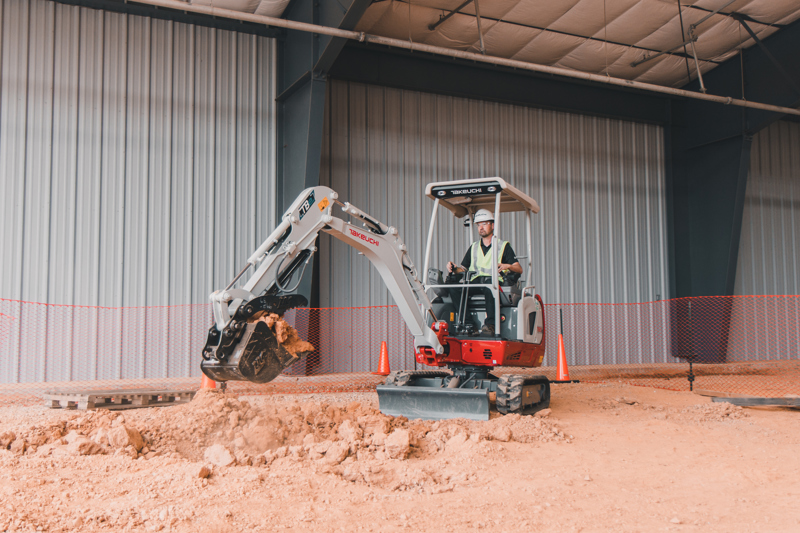Operating excavators on slopes and uneven terrain requires a deep understanding of safety, technique, and machine capability. Whether you're preparing a construction site, performing trenching on a gradient, or clearing debris across undulating ground, the right approach ensures both efficiency and operator safety.
When using a Takeuchi excavator, you're working with a machine engineered for precision, stability, and control in challenging environments. However, the operator still plays a critical role in maximising safety and performance. Below, we explore the best practices for working with excavators on sloped and uneven ground.
Understand the Limits of Your Machine
Before any operation begins, it’s essential to understand the slope limitations of your Takeuchi excavator. Every machine has a rated maximum slope angle for safe operation. Exceeding this angle risks rollover, hydraulic instability, or mechanical strain.
Use the operator’s manual as your reference for safe gradient tolerances. As a general rule, most compact and standard excavators can safely operate on slopes up to 30 degrees, but this varies depending on model, attachment, and ground conditions.
Pre-Inspection of Terrain
Conduct a thorough site assessment before starting work. Look for the following risk indicators:
- Loose rocks or unstable soil
- Wet or muddy conditions
- Sharp drops or hidden voids
- Erosion or water damage
Mark any high-risk zones clearly and plan a path that minimises steep traversal. The advantage of a Takeuchi excavator is its ability to maintain traction and stability even on irregular terrain, but it’s always better to avoid potential hazards when possible.
Use Correct Travelling Techniques
When moving across a slope, travel with the track ends (idlers) facing uphill. This improves stability and helps keep the weight balanced. Avoid travelling diagonally on a slope, which increases the risk of tipping.
Keep the boom and attachment close to the ground when moving. A lowered boom lowers the machine’s centre of gravity, reducing instability. For Takeuchi excavator operators, the intuitive control system makes it easier to manage subtle adjustments while navigating slopes.
Dig from the Top, Not the Bottom
If trenching or digging on a hill, work from the top of the slope downward. Digging from below can cause the slope to collapse, putting the excavator at risk of sliding or tipping.
On steeper grades, consider benching—removing material in tiers or layers to create stable working levels. This technique reduces pressure on the slope and gives the excavator more secure footing.
Avoid Sudden Movements
Smooth, deliberate control is vital on uneven ground. Avoid sudden swings, rapid arm movements, or fast travel speed. Every movement should be planned, especially when using attachments like buckets or augers that may change the centre of gravity.
The hydraulics of a Takeuchi excavator are engineered for precise modulation, giving operators the control they need to manage delicate operations on challenging ground.
Optimise Track Positioning and Attachment Use
Tracked machines offer better ground contact than wheeled alternatives, especially on slopes. Always ensure both tracks are making full contact with the ground before beginning any digging operation.
Use a wider bucket where appropriate, as this provides more stability during digging. In some cases, tilting buckets or grading blades can help create level working areas for subsequent operations.
Monitor Load Distribution
The position of your load significantly affects excavator stability. Keep heavy loads close to the machine and avoid overreaching, particularly when operating on a side slope. Rotate the house slowly and keep the load low when turning or moving to a different location.
Takeuchi excavators are built with a low centre of gravity and reinforced undercarriages, helping maintain stability even under load, but proper handling remains essential.
Regular Maintenance is Crucial
Working in uneven conditions can accelerate wear on undercarriage components, hydraulics, and track systems. Regularly inspect for:
- Uneven track tension
- Worn sprockets or rollers
- Leaks in hydraulic lines
- Loosened bolts or frame components
Staying on top of maintenance ensures your Takeuchi excavator continues to deliver reliable performance in the most demanding environments.
Invest in Operator Training
Even with the most advanced machinery, the operator’s experience is key. Invest in training for slope navigation, emergency response techniques, and proper machine handling. Operators should be confident in assessing terrain, managing load angles, and recognising instability.
Excavating on slopes and uneven terrain introduces significant challenges, but with the right equipment and techniques, these challenges become manageable. A Takeuchi excavator offers the durability, stability, and control needed to operate safely across difficult conditions. By combining thoughtful planning with smart machine operation, you’ll minimise risk, improve productivity, and protect both personnel and equipment.




